
]]

A hybrid vehicle is one that uses two or more distinct types of power, such as submarines that use diesel when surfaced and batteries when submerged. Other means to store energy include pressurized fluid in hydraulic hybrids.

An electric vehicle (EV) is a vehicle that uses one or more electric motors for propulsion. It can be powered by a collector system, with electricity from extravehicular sources, or it can be powered autonomously by a battery. EVs include, but are not limited to, road and rail vehicles, surface and underwater vessels, electric aircraft, and electric spacecraft. For road vehicles, together with other emerging automotive technologies such as autonomous driving, connected vehicles, and shared mobility, EVs form a future mobility vision called Connected, Autonomous, Shared, and Electric (CASE) Mobility.

The AMC Hornet is a compact automobile manufactured and marketed by American Motors Corporation (AMC) and made from 1970 through 1977 — in two- and four-door sedan, station wagon, and hatchback coupe configurations. The Hornet replaced the compact Rambler American line, marking the end of the Rambler marque in the American and Canadian markets.

The AMC Concord is a compact car manufactured and marketed by the American Motors Corporation for model years 1978–1983. The Concord was essentially a revision of the AMC Hornet that was discontinued after 1977, but better equipped, quieter, and smoother-riding than the series it replaced. It was offered in four-door sedan, two-door coupé, three-door hatchback, and five-door station wagon configurations. The Concord was AMC's volume seller from the time it appeared until the introduction of the Renault Alliance.
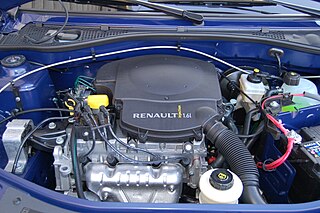
There are a wide variety of propulsion systems available or potentially available for automobiles and other vehicles. Options included internal combustion engines fueled by petrol, diesel, propane, or natural gas; hybrid vehicles, plug-in hybrids, fuel cell vehicles fueled by hydrogen and all electric cars. Fueled vehicles seem to have the advantage due to the limited range and high cost of batteries. Some options required construction of a network of fueling or charging stations. With no compelling advantage for any particular option, car makers pursued parallel development tracks using a variety of options. Reducing the weight of vehicles was one strategy being employed.

The Chevrolet Volt is a plug-in hybrid manufactured by General Motors, also marketed in rebadged variants as the Holden Volt in Australia and New Zealand and the Buick Velite 5 in China, and with a different fascia as the Vauxhall Ampera in the United Kingdom and as the Opel Ampera in the remainder of Europe. Volt production ended in February 2019.
All-electric range (AER) is the maximum driving range of an electric vehicle using only power from its on-board battery pack to traverse a given driving cycle. In the case of a Battery electric vehicle (BEV), it means the maximum range per recharge, typically between 150 and 400 miles. For a plug-in hybrid electric vehicle (PHEV), it means the maximum range in charge-depleting mode, typically between 20 and 40 miles. PHEVs can travel considerably further in charge-sustaining mode which utilizes both fuel combustion and the on-board battery pack like a conventional hybrid electric vehicle (HEV).

An electric vehicle battery is a rechargeable battery used to power the electric motors of a battery electric vehicle (BEV) or hybrid electric vehicle (HEV).

An electric car or electric vehicle (EV) is an automobile that is propelled by one or more electric traction motors, using only energy stored in batteries. Compared to conventional internal combustion engine (ICE) vehicles, electric cars are quieter, more responsive, have superior energy conversion efficiency and no exhaust emissions and lower overall vehicle emissions. The term "electric car" normally refers to battery electric vehicle (BEV), but broadly may also include plug-in hybrid electric vehicle (PHEV), range-extended electric vehicle (REEV) and fuel cell electric vehicle (FCEV).

A battery electric vehicle (BEV), pure electric vehicle, only-electric vehicle, fully electric vehicle or all-electric vehicle is a type of electric vehicle (EV) that exclusively uses chemical energy stored in rechargeable battery packs, with no secondary source of propulsion. BEVs use electric motors and motor controllers instead of internal combustion engines (ICEs) for propulsion. They derive all power from battery packs and thus have no internal combustion engine, fuel cell, or fuel tank. BEVs include – but are not limited to – motorcycles, bicycles, scooters, skateboards, railcars, watercraft, forklifts, buses, trucks, and cars.
The BugE is a one-passenger, three-wheeled battery electric vehicle designed by Mark Murphy of Blue Sky Design in 2007. It can reach up to 40 mph in standard form, and can run for 30 miles on a full charge. The BugE is licensed as a motorcycle and can run on all major streets in the United States of America. A fully completed BugE vehicle is as of May 2015 is listed at $5,732.30 USD.
Apollo Energy Systems is a U.S. multinational alternative energy corporation headquartered in Pompano Beach, Florida, that develops, produces, and markets fuel cell power plants, electric propulsion systems, and alternative energy generation equipment. The company was founded by Robert R. Aronson in 1966 as the Electric Fuel Propulsion Corporation (EFP) in New Orleans, Louisiana. It later became known as the Electric Auto Corporation (EAC), and in 2001 changed to Apollo Energy Systems.

The Cadillac ELR is a two-door, four-passenger luxury plug-in hybrid compact coupé manufactured and marketed by Cadillac for model years (MY) 2014 and 2016 – with a hiatus for MY 2015. Using a retuned version of the Chevrolet Volt's Voltec EREV drivetrain, the ELR's lithium-ion battery pack delivers an all-electric range of 37–39 miles (60–63 km) and a top speed of 106 mph (171 km/h).
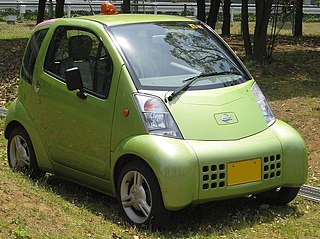
The Hypermini is a two-seater electric microcar by Nissan Motors, which produced 219 of the cars in 1999–2001 for the Japanese market.
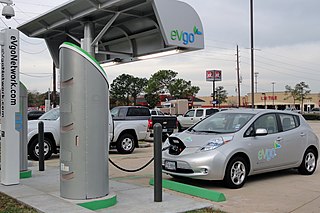
Range anxiety is the driver's fear that a vehicle has insufficient energy storage to cover the road distance needed to reach its intended destination, and would thus strand the vehicle's occupants mid-way. The term, which is now primarily used in reference to the practical driving range of battery electric vehicles (BEVs), is considered to be one of the major psychological barriers to large-scale public adoption of electric cars.

The Ford Focus Electric is a 5-door hatchback electric car that was produced by Ford. The Focus Electric is Ford's second production all-electric vehicle, and was made from December 2011 to May 2018.

The second generation Chevrolet Volt plug-in hybrid electric compact car produced by General Motors under the Chevrolet brand. It debuted at the 2015 North American International Auto Show to replace the original Volt, on sale since 2010. Retail deliveries as a 2016 model year began in October 2015 in the U.S. and Canada, and it was released in Mexico in December 2015. Availability of the 2016 model was limited to California and the other 10 states that follow California's zero emission vehicle regulations. It went on sale as a 2017 model year in the rest of the U.S. in February 2016. Volt production ended on February 15, 2019.
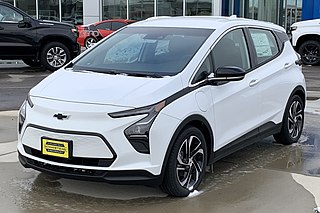
}}
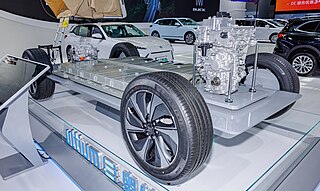
Ultium is an electric vehicle battery and motor architecture developed by General Motors. It is being deployed for battery electric vehicles from General Motors portfolio brands along with vehicles from Honda and Acura.


















